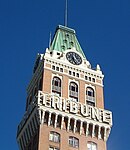Oakland Asian Cultural Center
The Oakland Asian Cultural Center, also referred to as the OACC, is an Oakland-based nonprofit cultural center that carries out Asian and Pacific Islander American arts and culture programs. It is located in the Pacific Renaissance Plaza in Oakland Chinatown, residing three blocks away from the 12th Street Civic Center BART station on Broadway. In the early 1980s, a community coalition asked for a space for a pan-Asian Cultural Center and the Asian Library, expressing a desire for an artistic and cultural space in the Chinatown area of Oakland. Historian Eve Ma notes that the Oakland Asian Cultural Center started in December 1984 as the East Bay Chinese Culture Center. In 1987, as it began acquiring help from the city government and recognizing that Chinatown's composition had changed, the Center changed its name, broadening its aim to include all Asian cultures."Since opening its own facility in 1996 Oakland’s Chinatown district, the OACC has offered cultural programs including performances, workshops, festivals, school tours, classes, and exhibitions.
Excerpt from the Wikipedia article Oakland Asian Cultural Center (License: CC BY-SA 3.0, Authors).Oakland Asian Cultural Center
Webster Street, Oakland
Geographical coordinates (GPS) Address Nearby Places Show on map
Geographical coordinates (GPS)
| Latitude | Longitude |
|---|---|
| N 37.800454722222 ° | E -122.2717025 ° |
Address
Pacific Renaissance Plaza (988 Franklin Street)
Webster Street
94607 Oakland
California, United States
Open on Google Maps










